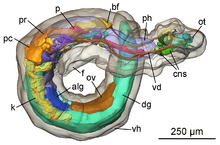Pseudunela viatoris
| Pseudunela viatoris | |
|---|---|
 | |
| A live Pseudunela viatoris hf – head-foot complex. | |
| Scientific classification | |
| Kingdom: | Animalia |
| Phylum: | Mollusca |
| Class: | Gastropoda |
| (unranked): | clade Heterobranchia clade Euthyneura clade Panpulmonata clade Acochlidiacea clade Hedylopsacea[1] |
| Family: | Pseudunelidae |
| Genus: | Pseudunela |
| Species: | P. viatoris |
| Binomial name | |
| Pseudunela viatoris Neusser, Jörger & Schrödl, 2011[2] | |
Pseudunela viatoris is a species of sea slug, an acochlidian, a shell-less marine gastropod mollusk in the family Pseudunelidae.
The specific name viatoris is after the Latin word “viator” (engl. pilgrim/voyager) according to its supposed ability to travel over long distances.[2]
Distribution
Pseudunela viatoris is known from Viti Levu, Fiji and Gili Lawa Laut, Indonesia.[2] The type locality is Fiji, Viti Levu, Laucala Bay, Nukumbutho Island, GPS: 18°10.47′S, 178°28.34′E.[2]
Description

lt – labial tentacle,
rh – rhinophore,
ey – eye,
hb – heart bulb,
dg – digestive gland,
vh – visceral hump.
The body size of living specimens of Pseudunela viatoris is 3-4 mm.[2] The body is divided into an anterior head-foot complex and a posterior elongated visceral hump.[2] The paired labial tentacles are broad at the base and taper to the end.[2] The rhinophores are tapered and shorter and thinner than the labial tentacles.[2] The densely ciliated foot is as broad as the anterior head-foot complex and extends about one third of the elongated visceral hump.[2] The heart bulb is visible externally in the anterior part of the visceral hump on the right body side.[2] Subepidermal, needle-shaped calcareous spicules are sparsely distributed in the cephalic tentacles, the foot and the visceral hump; in the anterior part of the latter they are larger than in the posterior part.[2] The body colour is whitish translucent, the digestive gland is brownish coloured (in specimens from Indonesia: orange-brownish shining through the epidermis).[2] Epidermal glands are distributed particularly over the visceral hump.[2] Whereas eyes are not visible externally in specimens from Fiji, eyes are weakly visible in some specimens from Indonesia.[2] Eye diameter is 30-35 µm.[2]

ot – oral tube,
cns – central nervous system,
ph – pharynx,
vd – vas deferens,
bf – basal finger,
p – penis,
pr – prostate,
pc – pericardium,
f – foot,
k – kidney,
alg – albumen gland,
ov – ovotestis,
vh – visceral hump,
dg – digestive gland.
Nervous system, digestive system, circulatory system, excretory system and reproductive system are described by Neusser et al. (2011) in detail.[2]
Ecology
Pseudunela viatoris is a minute species that lives in the spaces between sand grains in saltwater habitats, and it is thus considered to be a mesopsammic, marine interstitial animal that is part of the meiofauna of marine sands.[2]
References
This article incorporates CC-BY-2.5 text from the reference[2]
- ↑ Schrödl M. & Neusser T. P. (2010). "Towards a phylogeny and evolution of Acochlidia (Mollusca: Gastropoda: Opisthobranchia)". Zoological Journal of the Linnean Society 158: 124-154. doi:10.1111/j.1096-3642.2009.00544.x.
- 1 2 3 4 5 6 7 8 9 10 11 12 13 14 15 16 17 18 Neusser T. P., Jörger K. M. & Schrödl M. (2011). "Cryptic Species in Tropic Sands – Interactive 3D Anatomy, Molecular Phylogeny and Evolution of Meiofaunal Pseudunelidae (Gastropoda, Acochlidia)". PLoS ONE 6(8): e23313. doi:10.1371/journal.pone.0023313.
External links
| Wikimedia Commons has media related to Pseudunela viatoris. |